Hydraulicking: In hydraulic mining a stream of water under high head is employed to break down the bank and excavate the gravel and to sweep it to the sluices. Additional running water (termed “bank” or “by-wash” water) usually is required to wash it to and through the sluices. The gold is recovered in part from cleaning the bedrock after the gravel has been removed but principally from clean-up of the riffled sluice boxes.
An adequate supply of water under high pressure is therefore required, and the construction of dams, ditches, flumes, or pipe lines or a combination of these is necessary to convey the water to the mine or pit. Pressure sometimes is supplied by power-driven pumps rather than by natural heads, but this adds substantially to the mining cost. The excavating power of the water varies with the pressure and also the quantity, and yardage that can be handled per day will vary with this and with the total quantity of water (pressure water plus running or “by-wash” water). The cutting and sweeping capacity of the pressure water is usually greater than its carrying capacity after it becomes merely a stream of running water, and therefore additional “bank” water generally is required to wash the gravel through the sluices and ultimately to the tailings pile. If the “by-wash” water is run over the crest of the bank, as in ground sluicing, it may aid materially in cutting down the bank and carrying the gravel to the sluices.
Hydraulic mining is employed principally for excavating thick deposits, but in Alaska it has been used widely for mining creek placers and bench deposits, many of which are but slightly above the creek level. Hydraulicking or “piping” also is used to remove the overburden from the pay gravels, the latter then being mined by other methods. For good results the bedrock slope should be at least 2 percent for finely divided material, 4 or 5 percent for medium-size material, and more for coarse material. If there is not enough natural slope for moving the gravel to and through the sluices and for disposal of the tailings, it becomes necessary to sweep it to a pit or sump and elevate it by means of Ruble or hydraulic elevators or by mechanical means to sluices supported on trestles. Hydraulic mining usually is seasonal, being restricted to periods of maximum run-off.
Pressure water is piped to the pit, usually from a penstock, and is directed against the gravel bank by nozzles termed “giants” or “monitors.” These can be swung to direct the jet against desired points in the bank or to sweep the excavated gravel along the bedrock to the sluice head or sump, as the case may be. Table 46 gives data on flow of water through giants.
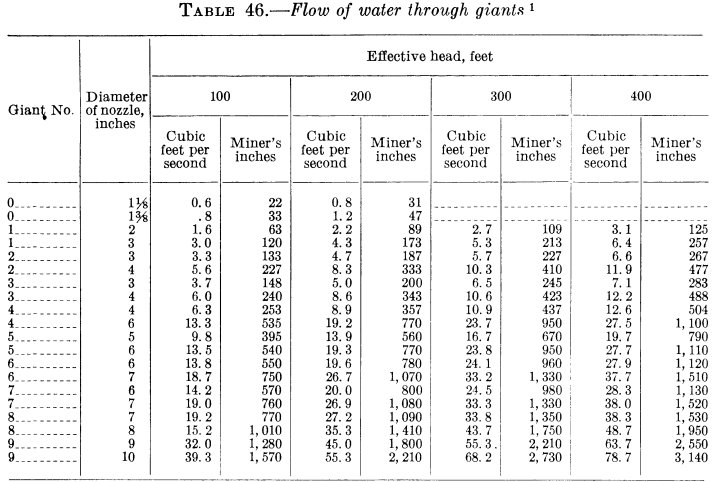
Table 47 contains operating data on a number of hydraulic mines in the Western United States that are believed to be typical of recent operations. These data are from Information Circular 6787.
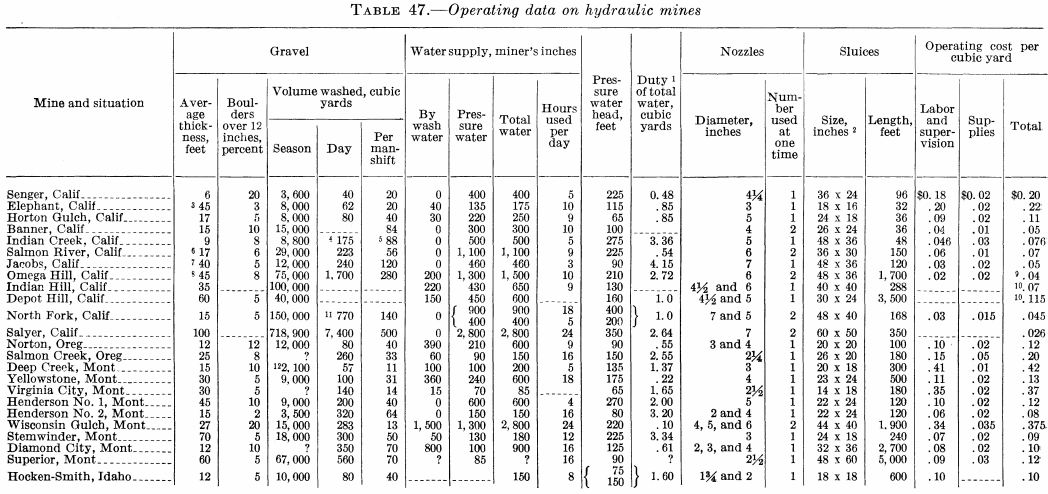
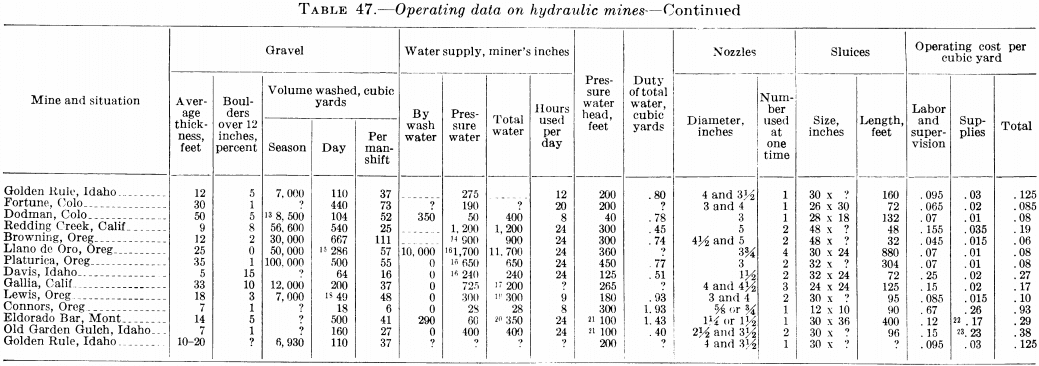
Excavation by Teams or Power-Operated Equipment other than Dredges
During the last decade conventional excavating machinery such as drag scrapers, power shovels, draglines, tractors, trucks, and bulldozers have been adapted to placer mining. Although the earlier adaptations often were commercially unsuccessful, a technique was developed rapidly that resulted in numerous successful operations. They are applicable to the mining of deposits too small to warrant capital expenditures for standard bucket dredges or deposits otherwise unsuited for dredging and to deposits too low in grade to be worked profitably by small-scale hand methods and to those where there is an insufficient volume of water for ground sluicing and insufficient head for hydraulic mining. The excavating and transporting equipment is used with washing and gold-saving plants, which may be either stationary on land, mobile on land, or mounted on a barge or pontoons floating in a pond.
Gardner, Johnson, Allsman, and others have discussed the equipment, methods of operation, and costs in a number of Bureau of Mines publications and numerous articles on the subject have appeared in the technical journals.
Teams and tractors.—Teams may be employed in small-scale work for the selective mining of thin gravels and may be used in shallow water where a tractor could not operate. The gravel usually is loosened by hand-picking or plowing and drag scrapers excavate and pull the material to the head of the sluice. In some cases barren soil over the deposit may be dragged to one side, uncovering the pay dirt. In others, where some water is available for ground sluicing, the overburden may be washed off after it has been loosened by plowing or harrowing. The gravel often is delivered to a trommel at the head of the sluice for disintegration, washing, and screening out the boulders or coarse particles before it passes to the sluices.
Tractors are used at a number of places instead of teams for pulling drag scrapers, greatly increasing the excavating and hauling capacity of the equipment and reducing the hand labor required for loosening the ground by picking.
Another method employs two- or three-drum clutched hoists for handling drag scrapers. The hoist is set at the receiving hopper or bin and by means of a pull rope on one drum attached to the front or bail of the scraper drags the scraper into the gravel and pulls the load to the bin. A tail or “back-haul” rope on the other drum passes through a sheave suitably anchored to a mast or deadman and thence to the back of the scraper and drags the empty scraper back to the pit. By moving the tail sheave, the scraper can be made to dig from all directions about the hoist. Various methods are employed for anchoring the tail sheave; for example, instead of a deadman or an anchor rope stretched between two deadmen, a heavily weighted car or truck may be used, which can be moved readily and quickly when it becomes necessary to change the line of drag. For digging in coarse, bouldery gravel or in hardpan, a hoe or open-bottom scraper is the most efficient type (considered purely as an excavator) but is liable to drop much of the gold en route to the washing plant. On the other hand, although a closed-bottom scraper will retain the excavated material better, it is an inefficient digging machine in coarse, rubbly material. Figure 124 shows a typical drag-scraper layout.
A closed-type bucket operating on a slackline cableway may be employed instead of a drag scraper. The bucket usually is similar to a toothed drag scraper but has a solid bottom and is hung below a carrier block by a swinging bail. The carrier block travels on a track cable between the loading and dumping points. One end of the track cable is anchored to a deadman or bridle cable and the other is attached to a tackle block on the end of a tension cable. The tension cable is reeved through blocks on a mast and then passes to the drum of a hoist. The carrier with bucket suspended below it runs by gravity on the inclined tightened track cable to a position above the loading point. By “slacking off” the track cable the bucket is lowered to the ground.
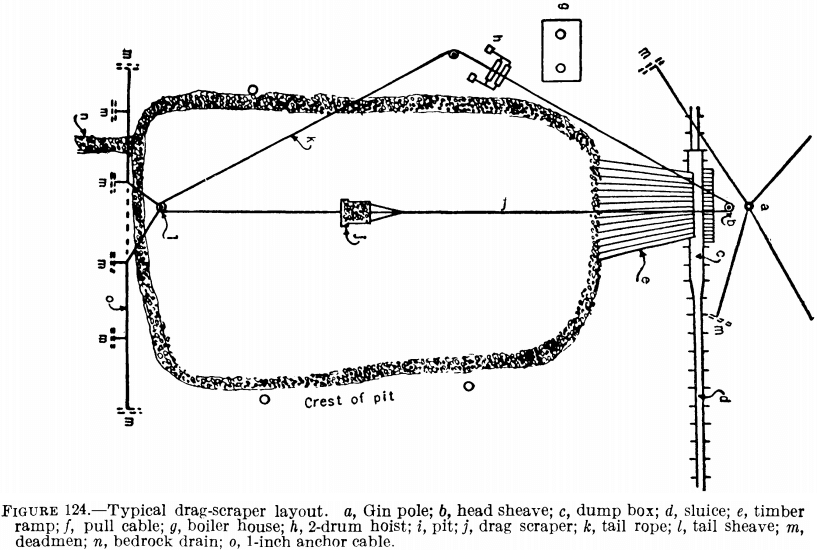
A drag or inhaul cable, one end of which is attached to the front end of the bucket and the other to a second hoist drum, is then used to drag the bucket ahead until it has obtained a load. The tension cable is then tightened, which raises the track cable and with it the carrier and bucket, and the inhaul hoist is thrown into gear, carrier and bucket being pulled back to the dumping point near the mast. With this type of equipment, gold once in the bucket is retained until the dump is reached. In addition to the scraper and hoist, masts, and heavy overhead cables, a carrier and traveler block are required, increasing the first cost of equipment and the installation cost. Slackline cableways are not as flexible in operation and are not as readily moved to enable excavation of the entire area, which is often irregular in shape.
Table 48 gives some data on placer operations employing scrapers.
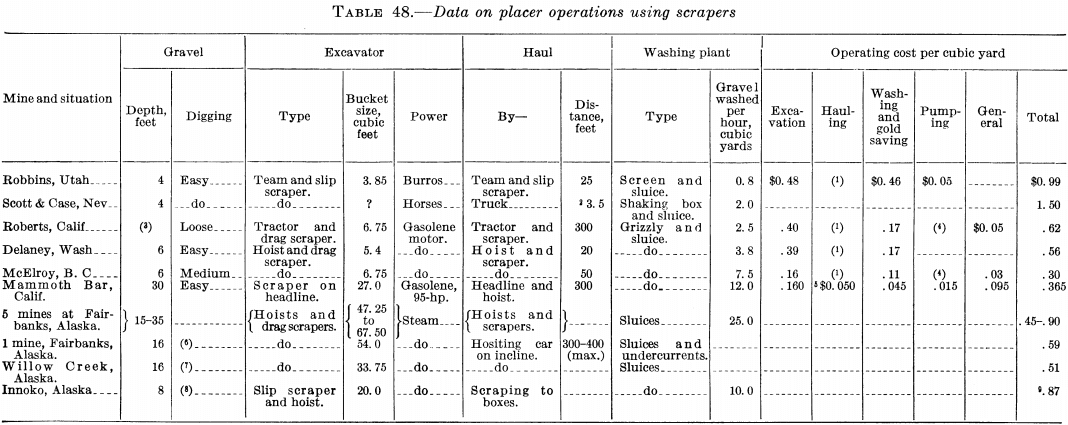
Power shovels and dragline excavators.—Both power shovels and dragline excavators have been used successfully in placer mining during recent years, and each has its particular field. The digging element of the power shovel is a dipper attached to a rigid dipper stick, which, together with the hoist rope, thrusts the dipper into the gravel bank. The dragline excavator is similar in appearance but usually has a longer boom, and the digging element is a form of drag scraper having no dipper stick. The scraper is attached, front and back, by suitable bridles to a rope, one leg of which passes over a crown pulley on the end of the boom and thence to the hoist drum, and the other leg to the companion hoist drum. The dragline bucket then loads itself in the same manner as a drag scraper, but instead of the load being dragged to the discharge point it is hoisted to the required dump elevation and may be swung by revolving the boom or the entire machine, as the case may be.
Caterpillar mounting generally is employed for both shovel and dragline excavators of the full-revolving type. Dragline excavators can dig considerably below grade and under water; by means of the longer boom, they can deposit the gravel at a greater distance from the machine. This type of excavator, therefore, usually is employed when the washing and gold-saving plant is mounted on a float. The dragline works from the top of the bank, whereas the shovel works down in the pit. Bulldozers often are used for removal of soil overburden prior to mining the gravel and for cleaning up corners, pushing gravel up to the shovel, or leveling tailing piles.
